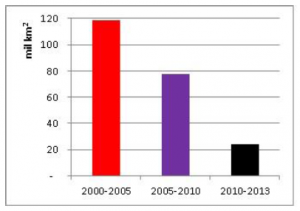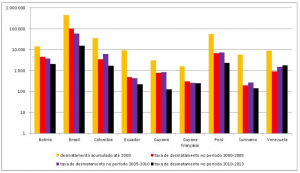The Amazonian Network of Georeferenced Socio-Environmental Information (RAISG) reveals in a recent publication that the loss of original forest cover of the Amazon rainforest decelerated between 2000 and 2013 relative to the 1970-2000 period. Despite this deceleration, figures remain high within the entire region for the three periods analyzed (200-2005-2010-2013). The study estimates that 222,248 km 2 were deforested in the region between 2000 y 2013, an expanse equivalent to the territory of the United Kingdom.
Deforestation in the Amazon (2000-2013) (km 2 )
Deforestation in the Amazon (1970-2013) is the title of this study, which analyzes historic and recent deforestation trends in all the countries of the Amazon region. The cumulative deforestation up to 2013 corresponds to 13.3% of the original forest cover of the Amazon, according to this analysis. The largest loss of original forest cover (9.7%) took place between 1970 and 2000, and the remaining 3.6% loss happened between 2000 and 2013.
The deceleration of deforestation in the thirteen years elapsed between 2000 and 2013 is clearly correlated in Brazil, Bolivia and Ecuador, while Colombia, Peru, Suriname, French Guiana and Guiana either experienced surges in intervening periods or showed evidence of stabilization. The only country that displays the opposite tendency is Venezuela, with evidence of acceleration of forest loss.
Deforestation in the Amazon by country (km 2 )
Moreover, the publication warns about strong pressures to the headwaters of large hydrographic basins –located in Andean countries- as a consequence of land-use changes and water contamination led by economic activities in the area. RAISG intends to further study this situation, which poses a significant threat to forests, to the water that sources rivers and maintains their fauna, and to the human population that rely on them.
Data was obtained by the RAISG network partners through satellite image analysis in combination with SIG geographical analysis. The use of a standard methodology allowed analysis at a regional level, without excluding national differences.
Other relevant findings:
- In the Bolivian Amazon forest loss reached close to 10 thousand km 2 between 2000 and 2013. The three major direct drivers are cattle ranching, industrial agriculture and small-scale agriculture (p. 14).
- In the Brazilian Amazon the rate of deforestation decreased starting 2006. However, in the 2000 – 2013 period 174,000 km 2 of forest were lost, or 5% of the original forest cover. This loss is mainly associated with agriculture and cattle ranching (p. 16).
- In the Colombian Amazon deforestation increased significantly in the 2005-2010 period when 6,167 km 2 of forest were lost. The 2010-2013 period recorded a loss of 1,684 km 2 . The primary pressures on the Colombian Amazon are the expansion of the agricultural frontier and illegal mining. (p. 23)
- The Ecuadorian Amazon evinces the second largest proportional cumulative forest loss of the region, with a deforestation of 10.7% of its original forest. The oil industry remains the primary threat. (p. 28).
- The Peruvian Amazon experienced the fourth major cumulative forest loss in the region (9.1%) between 2010 and 2013. Agriculture and cattle ranching are important direct drivers of deforestation, but starting in 2009 agroindustrial plantations (palm and cacao) are a growing threat that demands increasingly larger concessions of primary forest. (pp. 32-35)
- In the Venezuelan Amazon, in contrast with the regional trend, forest loss increased progressively between 2005 and 2013. In the context of the Venezuelan Amazon territory, the deforested area is relatively low (3.3%), but the sustained increase is worrisome. Illegal mining stands out as one of the main threats to the forest. (pp. 36- 39).
- In the Amazon of Suriname, Guiana, and French Guiana the growing demand for energy to sustain their economic growth is a threat. Jointly, the three Guianas have lost 3.2% of their forests, but Guiana and French Guiana showed higher loss rates (1%) between 2000 and 2013 than Suriname (0.4%).


